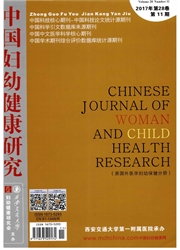

 中文摘要:
中文摘要:
目的 通过分析产褥期急性肺动脉栓塞(PE)的临床特点,提高对该病的诊疗水平。方法 回顾性收集2009年1月至2015年12月在西安交通大学第一附属医院诊断的19例产褥期急性PE及12例非PE患者,分析其临床表现及实验室检查结果 。结果 与非PE患者相比,急性PE患者主要表现为突发性呼吸困难和呼吸急促,两组间比较差异均有统计学意义(x^2值分别为6.09、13.46,均P〈0.05),而胸疼和咳血症状组间比较无明显差异(均P〉0.05)。有11例急性PE患者伴有心动过速,8例PE患者伴有下肢深静脉血栓,与非PE组对比差异均有统计学意义((x^2值分别为5.13、6.81,均P〈0.05)。另外,在22例血浆D-二聚体水平升高的患者中,有17例为急性PE患者,与非PE组比较差异有统计学意义(x^2=8.16,P〈0.05)。结论 产褥期急性PE患者临床表现多样化,产妇主要表现为呼吸困难和呼吸急促,如果同时伴有静脉血栓栓塞(VTE)和血浆D-二聚体检查阳性,将有助于对PE更加有效的诊断。
 英文摘要:
英文摘要:
Objective To improve the diagnosis and treatment level for pulmonary embolism (PE) during puerperium by analyzing its chnical manifestations. Methods From January 2009 to December 2015, a total of 19 postpartum patients with PE and 12 non-PE patients diagnosed in the First Affiliated Hospital of Xi' an Jiaotong University were analyzed retrospectively for clinical manifestations and laboratory results. Results The most common symptoms of cases of acute PE were sudden dyspnea and ecphysesis, and these symptoms showed significant differences between two groups (X2 value was 6.09 and 3.46, respectively, both P 〈 0.05 ), but there were no significant differences in chest pain and hemoptysis ( both P 〉 0.05). There were 11 cases of PE with tachycardia and 8 with deep venous thrombosis of lower limbs respectively, which showed significant differences compared with non-PE cases (X2 value was 5.13 and 6.81, respectively, both P 〈 0.05). Moreover, of 22 cases with increased plasma level of D-dimer, there were 17 cases of acute PE. There was significant difference between two groups (X2 = 8.16,P 〈 0.05). Conclusion The clinical manifestations of acute PE during puerperium are various. The popular symptoms are ecphysesis and dyspnea. If puerperas have these symptoms accompanied by venous thromboembolism (VTE) and D-dimer testing positive, it is helpful for effective diagnosis of PE.
 同期刊论文项目
同期刊论文项目
 同项目期刊论文
同项目期刊论文
 Heme oxygenase-1/p21WAF1 mediates peroxisome proliferator-activated receptor-gamma signaling inhibit
Heme oxygenase-1/p21WAF1 mediates peroxisome proliferator-activated receptor-gamma signaling inhibit Inhibition of cGMP phosphodiesterase 5 suppresses matrix metalloproteinase-2 production in pulmonary
Inhibition of cGMP phosphodiesterase 5 suppresses matrix metalloproteinase-2 production in pulmonary Inhibition of ubiquitin proteasome function suppresses proliferation of pulmonary artery smooth musc
Inhibition of ubiquitin proteasome function suppresses proliferation of pulmonary artery smooth musc 期刊信息
期刊信息
